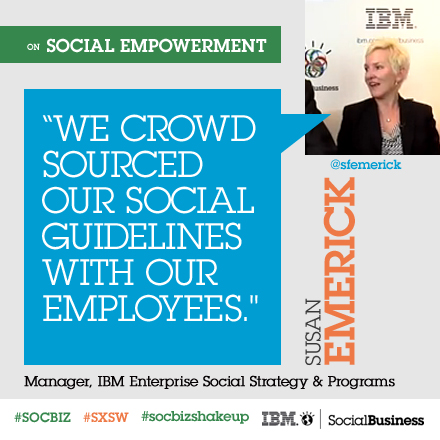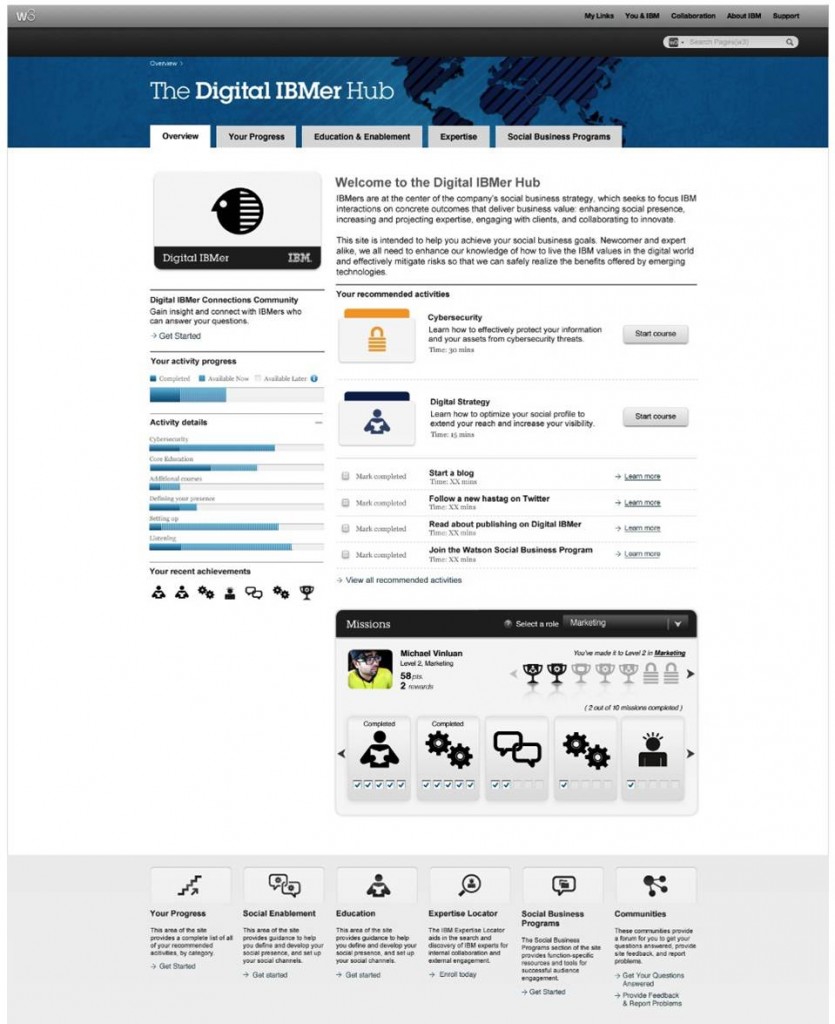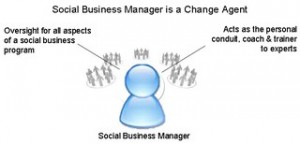In the spring of 2005, IBMers used a wiki to create a set of guidelines for all IBMers who wanted to blog. These guidelines aimed to provide helpful, practical advice to protect both IBM bloggers and IBM. In 2008 and again in 2010 IBM turned to employees to re-examine our guidelines in light of ever-evolving technologies and online social tools to ensure they remain current to the needs of employees and the company. These efforts have broadened the scope of the existing guidelines to include all forms of social computing.

Below are the current and official “IBM Social Computing Guidelines,” which we review periodically so that they may evolve to reflect emerging technologies and online social tools.
Responsible engagement in innovation and dialogue
Online collaboration platforms are fundamentally changing the way IBMers work and engage with each other, clients and partners.
IBM is increasingly exploring how online discourse through social computing can empower IBMers as global professionals, innovators and citizens. These individual interactions represent a new model: not mass communications, but masses of communicators. Through these interactions, IBM’s greatest asset—the expertise of its employees—can be shared with clients, shareholders, and the communities in which it operates.
Therefore, it is very much in IBM’s interest—and, we believe, in each IBMer’s own—to be aware of and participate in this sphere of information, interaction and idea exchange:
- To learn: As an innovation-based company, we believe in the importance of open exchange-between IBM and its clients, and among the many constituents of the emerging business and societal ecosystem—for learning. Social computing is an important arena for organizational and individual development.
- To contribute: IBM—as a business, as an innovator and as a corporate citizen—makes important contributions to the world, to the future of business and technology, and to public dialogue on a broad range of societal issues. Because our business activities provide transformational insight and high-value innovation for business, government, education, healthcare and nongovernmental organizations, it is important for IBM and IBMers to share with the world the exciting things we’re learning and doing.
In 1997, IBM actively recommended that its employees use the Internet-at a time when many companies were seeking to restrict their employees’ Internet access. In 2003, the company made a strategic decision to embrace the blogosphere and to encourage IBMers to participate. We continue to advocate IBMers’ responsible involvement today in this rapidly growing environment of relationship, learning and collaboration.
IBM Social Computing Guidelines
- Know and follow IBM’s Business Conduct Guidelines.
- IBMers are personally responsible for the content they publish on-line, whether in a blog, social computing site or any other form of user-generated media. Be mindful that what you publish will be public for a long time-protect your privacy and take care to understand a site’s terms of service.
- Identify yourself-name and, when relevant, role at IBM-when you discuss IBM-related matters such as IBM products or services. You must make it clear that you are speaking for yourself and not on behalf of IBM.
- If you publish content online relevant to IBM in your personal capacity it is best to use a disclaimer such as this: “The postings on this site are my own and don’t necessarily represent IBM’s positions, strategies or opinions.”
- Respect copyright, fair use and financial disclosure laws.
- Don’t provide IBM’s or a client’s, partner’s or supplier’s confidential or other proprietary information and never discuss IBM business performance or other sensitive matters about business results or plans publicly.
- Don’t cite or reference clients, partners or suppliers on business-related matters without their approval. When you do make a reference, link back to the source and do not publish content that might allow inferences to be drawn which could damage a client relationship with IBM.
- Respect your audience. Don’t use ethnic slurs, discriminatory remarks, personal insults, obscenity, or engage in any similar conduct that would not be appropriate or acceptable in IBM’s workplace. You should also show proper consideration for others’ privacy.
- Be aware of your association with IBM in online social networks. If you identify yourself as an IBMer, ensure your profile and related content is consistent with how you wish to present yourself with colleagues and clients.
- Spirited and passionate discussions and debates are fine, but you should be respectful of others and their opinions. Be the first to correct your own mistakes.
- Try to add value. Provide worthwhile information and perspective. IBM’s brand is best represented by its people and what you publish may reflect on IBM’s brand.
- Don’t misuse IBM logos or trademarks and only use them if you have the authority to do so. For example, you shouldn’t use IBM in your screen name or other social media ID.
The IBM Business Conduct Guidelines and laws provide the foundation for IBM’s policies and guidelines for blogs and social computing.
The same principles and guidelines that apply to IBMers’ activities in general, as found in the IBM Business Conduct Guidelines, apply to IBMers’ activities online. This includes forms of online publishing and discussion, including blogs, wikis, file-sharing, user-generated video and audio, virtual worlds and social networks.
As outlined in the Business Conduct Guidelines, IBM fully respects the legal rights of our employees in all countries in which we operate. In general, what you do on your own time is your affair. However, activities in or outside of work that adversely affect your IBM job performance, the performance of others, or IBM’s legitimate business interests are a proper focus for company policy.
IBM supports open dialogue and the exchange of ideas.
IBM regards blogs and other forms of online discourse as primarily a form of communication and relationship among individuals. When the company wishes to communicate publicly as a company-whether to the marketplace or to the general public-it has well established means to do so. Only those officially designated by IBM have the authorization to speak on behalf of the company.
However, IBM believes in dialogue among IBMers and with our partners, clients, members of the many communities in which we participate and the general public. Such dialogue is inherent in our business model of innovation, and in our commitment to the development of open standards. We believe that IBMers can both derive and provide important benefits from exchanges of perspective.
One of IBMers’ core values is “trust and personal responsibility in all relationships.” As a company, IBM trusts—and expects—IBMers to exercise personal responsibility whenever they participate in social media. This includes not violating the trust of those with whom they are engaging. IBMers should not use these media for covert marketing or public relations on behalf of IBM. If and when members of IBM’s Communications, Marketing, Sales or other functions engaged in advocacy for the company have the authorization to participate in social media, they should identify themselves as such.
Know the IBM Business Conduct Guidelines. If you have any confusion about whether you ought to publish something online, chances are the BCGs will resolve it. Pay particular attention to what the BCGs have to say about proprietary information, about avoiding misrepresentation and about competing in the field. If, after checking the BCG’s, you are still unclear as to the propriety of a post, it is best to refrain and seek the advice of management.
Be who you are. We believe in transparency and honesty. When discussing topics relevant to IBM’s products and services, you must use your real name, be clear who you are, and identify that you work for IBM. If you have a vested interest in something you are discussing, be the first to point it out. But also be smart about protecting yourself and your privacy. What you publish will be around for a long time, so consider the content carefully and also be judicious in disclosing personal details.
Be thoughtful about how you present yourself in online social networks. The lines between public and private, personal and professional are blurred in online social networks. By virtue of identifying yourself as an IBMer within a social network, you are now connected to your colleagues, managers and even IBM’s clients. You should ensure that content associated with you is consistent with your work at IBM. If you have joined IBM recently, be sure to update your social profiles to reflect IBM’s guidelines.
Speak in the first person. Use your own voice; bring your own personality to the forefront.
Use a disclaimer. Whenever you publish content to any form of digital media, make it clear that what you say there is representative of personal views and opinions and not necessarily the views and opinions of IBM. For instance, in your own blog, the following standard disclaimer should be prominently displayed: “The postings on this site are my own and don’t necessarily represent IBM’s positions, strategies or opinions.” If a site does not afford you enough space to include this full disclaimer, you should use your best judgment to position your comments appropriately.
Managers and executives take note: This standard disclaimer does not by itself exempt IBM managers and executives from a special responsibility when participating in online environments. By virtue of their position, they must consider whether personal thoughts they publish may be misunderstood as expressing IBM positions. And a manager should assume that his or her team will read what is written. Public forums are not the place to communicate IBM policies to IBM employees.
Respect copyright and fair use laws. For IBM’s protection and well as your own, it is critical that you show proper respect for the laws governing copyright and fair use of copyrighted material owned by others, including IBM’s own copyrights and brands. You should never quote more than short excerpts of someone else’s copyrighted work. And it is good general blogging practice to link to others’ work. Keep in mind that laws will be different depending on where you live and work.
Protecting confidential and proprietary information. Social computing blurs many of the traditional boundaries between internal and external communications. Be thoughtful about what you publish-particularly on external platforms. You must make sure you do not disclose or use IBM confidential or proprietary information in any online social computing platform. IBM confidential and proprietary information may include information regarding the development of systems, processes, products, know-how and technology. Additionally, internal reports, policies, procedures or other internal business-related confidential communications should not be posted.
Also, don’t post information about a person or another company unless you have the right to do so, taking into account intellectual property and privacy concerns. For example, ask permission before posting someone’s picture in a social network or publishing in a blog a conversation that was meant to be private.
IBM’s business performance and other sensitive “inside information”. Some topics relating to IBM are sensitive and should never be discussed, even if you’re expressing your own opinion and using a disclaimer. For example, you must not comment on, or speculate about things like IBM’s future business performance (including upcoming quarters or future periods), IBM’s business plans, unannounced strategies or prospects (including information about alliances), potential acquisitions or divestitures, similar matters involving IBM’s competitors. This applies to anyone including conversations with financial analysts, the press or other third parties (including friends). If you’re unsure of the sensitivity of a particular subject, seek advice from your manager or legal team before talking about it or simply refrain from the conversation. IBM policy is not to comment on rumors in any way about these issues. You should merely say, “no comment” to rumors. Do not deny or affirm them (or suggest the same in subtle ways), speculate about them or propagate them by participating in “what if”-type conversations.
Protect IBM’s clients, business partners and suppliers. Clients, partners or suppliers should not be cited or obviously referenced without their approval. Externally, never identify a client, partner or supplier by name without permission and never discuss confidential details of a client engagement. Internal social computing platforms permit suppliers and business partners to participate so be sensitive to who will see your content. If a client hasn’t given explicit permission for their name to be used, think carefully about the content you’re going to publish on any internal social media and get the appropriate permission where necessary.
It is acceptable to discuss general details about kinds of projects and to use non-identifying pseudonyms for a client (e.g., Client 123) so long as the information provided does not make it easy for someone to identify the client or violate any non-disclosure or intellectual property agreements that may be in place with the client. Be thoughtful about the types of information that you share, which may inadvertently lead others to deduce which clients, partners and suppliers that you are working with. This might include travel plans or publishing details about your current location or where you are working on a given day. Furthermore, your blog or online social network is not the place to conduct confidential business with a client, partner or supplier.
Respect your audience and your coworkers. Remember that IBM is a global organization whose employees and clients reflect a diverse set of customs, values and points of view. Don’t be afraid to be yourself, but do so respectfully. This includes not only the obvious (no ethnic slurs, personal insults, obscenity, etc.) but also proper consideration of privacy. For example, if your blog is hosted on an IBM-owned property, avoid these topics and focus on subjects that are business-related. If your blog is self-hosted, use your best judgment and be sure to make it clear that the views and opinions expressed are yours alone and do not represent the official views of IBM. Further, be thoughtful when using tools hosted outside of IBM’s protected Intranet environment to communicate among fellow employees about IBM or IBM related matters.
Add value. IBM’s brand is best represented by its people and everything you publish online reflects upon it. Blogs and social networks that are hosted on IBM-owned domains should be used in a way that adds value to IBM’s business. If it helps you, your coworkers, our clients or our partners to do their jobs and solve problems; if it helps to improve knowledge or skills; if it contributes directly or indirectly to the improvement of IBM’s products, processes and policies; if it builds a sense of community; or if it helps to promote IBM’s Values, then it is adding value. It is best to stay within your sphere of expertise, and whenever you are presenting something as fact, make sure it is a fact. Though not directly business-related, background information you choose to share about yourself, such as information about your family or personal interests, may be useful in helping establish a relationship between you and your readers, but it is entirely your choice whether to share this information.
When you see misrepresentations made about IBM by media, analysts or by other bloggers, you may certainly use your blog—or add comments on the original discussion—to point that out. Always do so with respect, stick to the facts and identify your appropriate affiliation to IBM. Also, if you speak about a competitor, you must make sure that what you say is factual and that it does not disparage the competitor. Avoid unnecessary or unproductive arguments. Brawls may earn traffic, but nobody wins in the end and you may negatively affect your own, and IBM’s, reputation in the process. Don’t try to settle scores or goad competitors or others into inflammatory debates. Here and in other areas of public discussion, make sure that what you are saying is factually correct.
Be the first to respond to your own mistakes. If you make an error, be up front about your mistake and correct it quickly, as this can help to restore trust. If you choose to modify content that was previously posted, such as editing a blog post, make it clear that you have done so.
Use your best judgment. Remember to always use good judgment and common sense in deciding what you publish. If you’re about to publish something that makes you even the slightest bit uncomfortable, review the suggestions above and think about why that is. If you’re still unsure, and it is related to IBM business, feel free to discuss it with your manager. Ultimately, however, you have sole responsibility for what you post to your blog or publish in any form of online social media.
Don’t forget your day job. You should make sure that your online activities do not interfere with performing your job responsibilities or commitments to customers.










